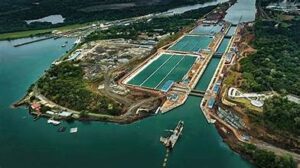The Panama Canal: A Strategic Economic Tug-of-War

The Panama Canal has long been a pivotal artery in global trade, but recent political shifts reveal the complexities of international relations tied to this historic structure. In a surprising turn of events, Panama has faced immense pressure from the United States to curtail Chinese influence within the canal operation, a move that may redefine the future of this essential trade route.
A High-Stakes Ultimatum
Amid growing concerns over Beijing’s increasing sway in Latin America, the U.S. State Department issued a stark ultimatum to Panama: act against foreign Chinese influence or face unspecified retaliatory measures. While the exact nature of these repercussions remains shrouded in mystery, Secretary of State Marco Rubio’s engagement with Panamanian President José Raúl Mulino underscores the seriousness of the situation.
In response to U.S. demands, Panama has announced the termination of several agreements with China ahead of their scheduled expiration dates of 2027 and 2028. This includes walking away from the controversial Belt and Road Initiative (BRI), which initially seemed to promise infrastructural growth but has since drawn skepticism about its true intentions and implications.
Shifting Alliances: The Panama-U.S. Relationship
Since becoming the first Latin American nation to join the BRI in 2018 after severing ties with Taiwan, Panama has struggled with a balancing act between mighty global players. By bracing for potential U.S. backlash, including whispers of the U.S. reclaiming control of the canal, Panama appears to be reorienting its geopolitical compass toward strengthening ties with America. This pivot is intended to attract fresh investments from U.S. sources, vital for the nation’s economic growth.
But this decision might be rooted more in urgency than strategy. Some analysts suggest that the swift response to U.S. allegations of overcharging U.S. vessels—despite 66% of traffic being tied to U.S. ports—seems a tactical retreat. The stakes couldn’t be higher for Panama, and its leadership recognizes the need to tread carefully in the face of powerful geopolitical forces.
Historical Significance of the Canal
The Panama Canal has always been more than just an engineering marvel. Theodore Roosevelt once described it as a “highway of civilization.” Before its construction, trade between the Atlantic and Pacific Oceans necessitated a perilous journey around South America that could take months. By identifying the narrowest land strip on the isthmus and constructing the canal, the United States established a pivotal shortcut for global trade.
Originally, control of the area belonged to Colombia, which allowed the French to attempt construction in the late 19th century, only to face bankruptcy. The U.S. stepped in, helping Panama gain independence in 1903 and subsequently constructing the canal by 1914 for a total cost of around $375 million (roughly $12 billion today). The impact was immediate: shipping times between New York and San Francisco were reduced by 8,000 miles, with about 5% of global trade flowing through this crucial passage.
The Torrijos-Carter Treaties: A Mixed Legacy
The Torrijos-Carter Treaties of 1977 marked a significant inflection point in U.S.-Panama relations, transferring full control of the canal back to Panama by 1999. Former President Jimmy Carter’s reflections reveal the complexity of this transition, as he acknowledged the ethical implications of U.S. actions surrounding the canal’s initial construction. Ironically, this agreement has since provoked debate about the long-term repercussions for U.S. influence in the region.
The aftermath of the treaty has indeed proven contentious. Critics argue that Carter unwittingly weakened America’s strategic foothold by relinquishing a critical economic asset, as U.S. shipping now incurs steadily rising tolls to use a canal it constructed. Notably, around 40% of U.S. container traffic passes through this vital thoroughfare, whose operational oversight Panama has not maintained in line with expectations.
What Lies Ahead for Panama?
As Panama seeks to strengthen its U.S. ties while extricating itself from previous commitments to China, the question remains: what does the future hold for the Panama Canal? At Extreme Investor Network, we believe that understanding these dynamics is essential for investors navigating the geopolitical landscape of global trade. The interplay of international diplomacy, economic strategy, and historical legacies will undoubtedly shape the future of the Panama Canal and the opportunities that arise within.
Stay tuned to our blog for deeper insights and analysis into how such global shifts can affect investment strategies and economic prospects. The world is changing rapidly, and with it, the potential for exciting investment opportunities aligned with emerging market trends.

